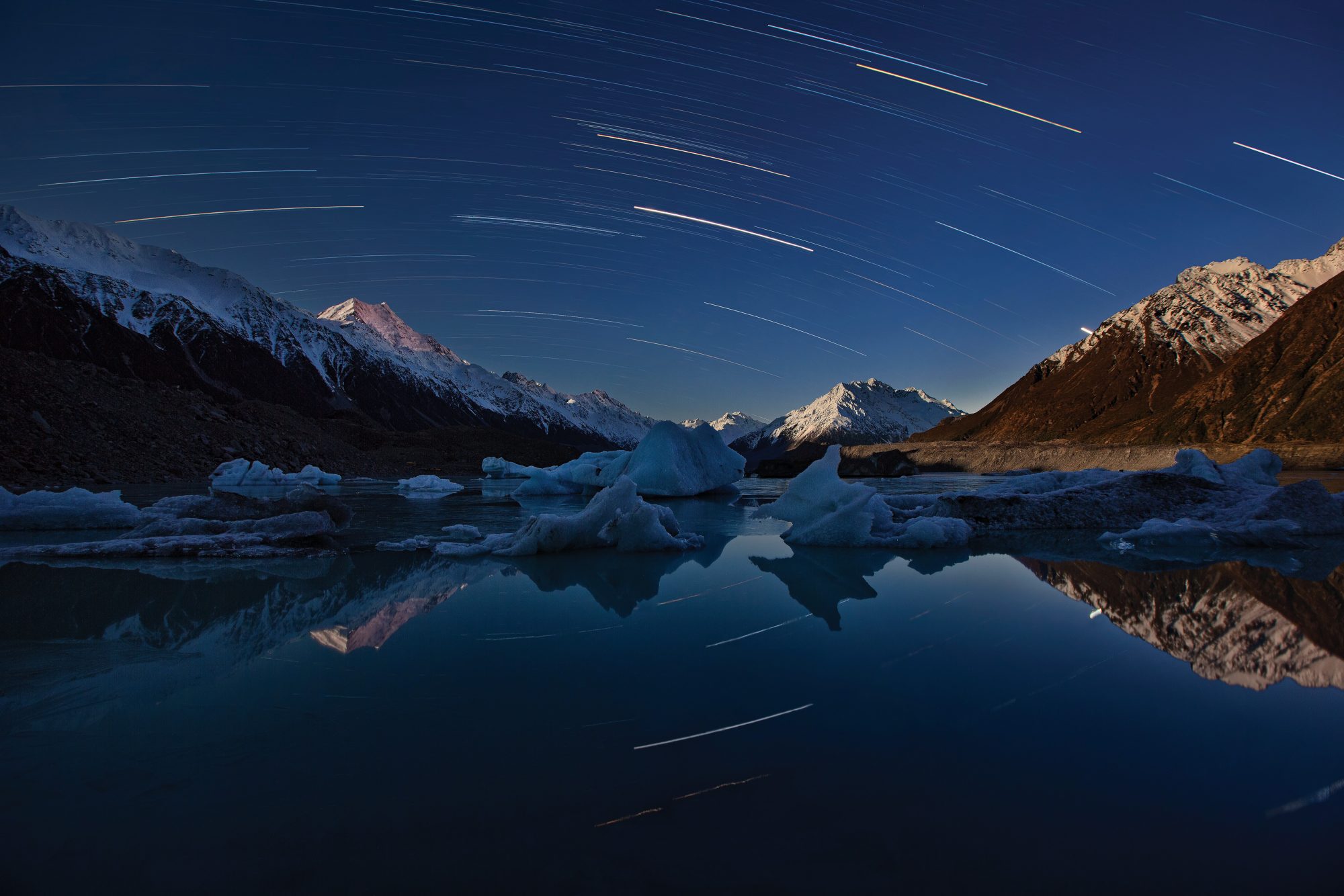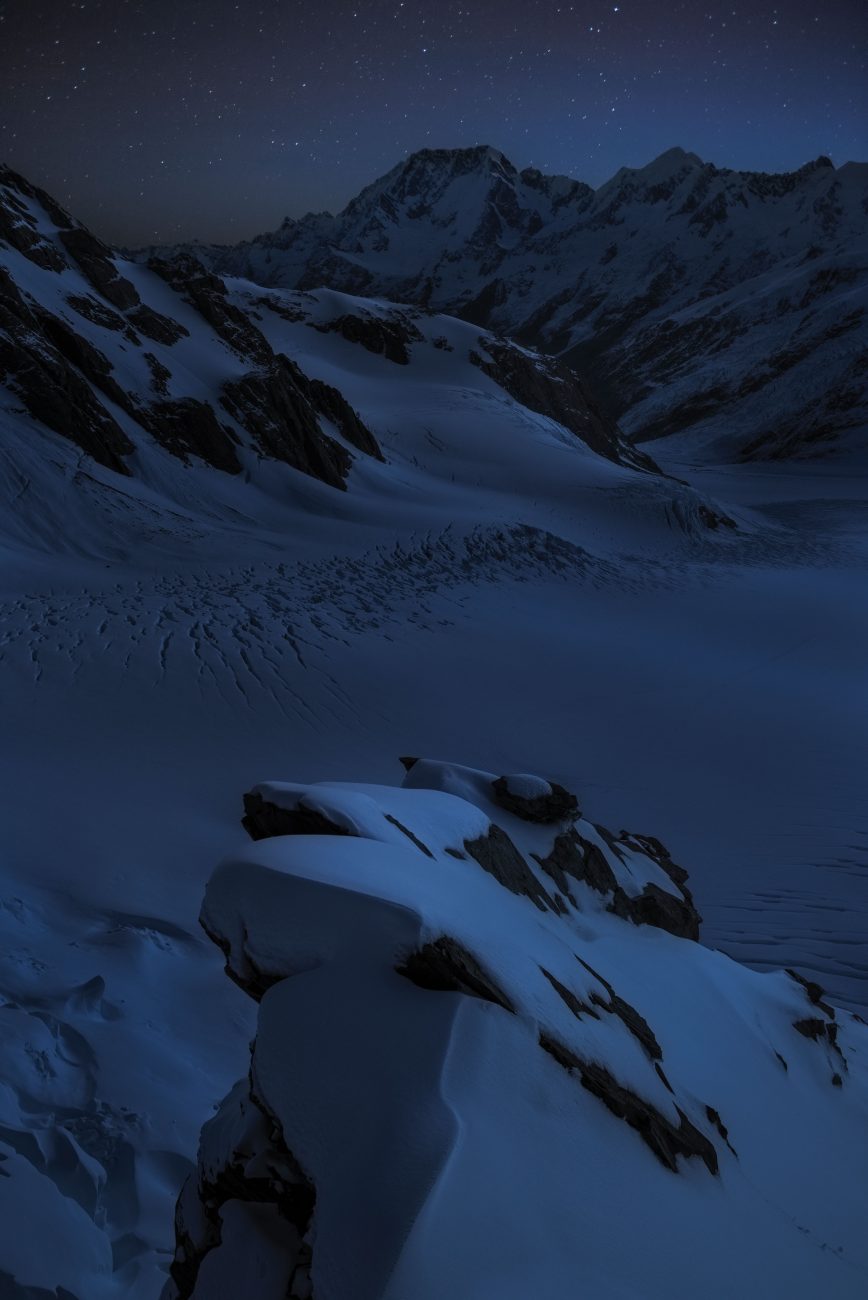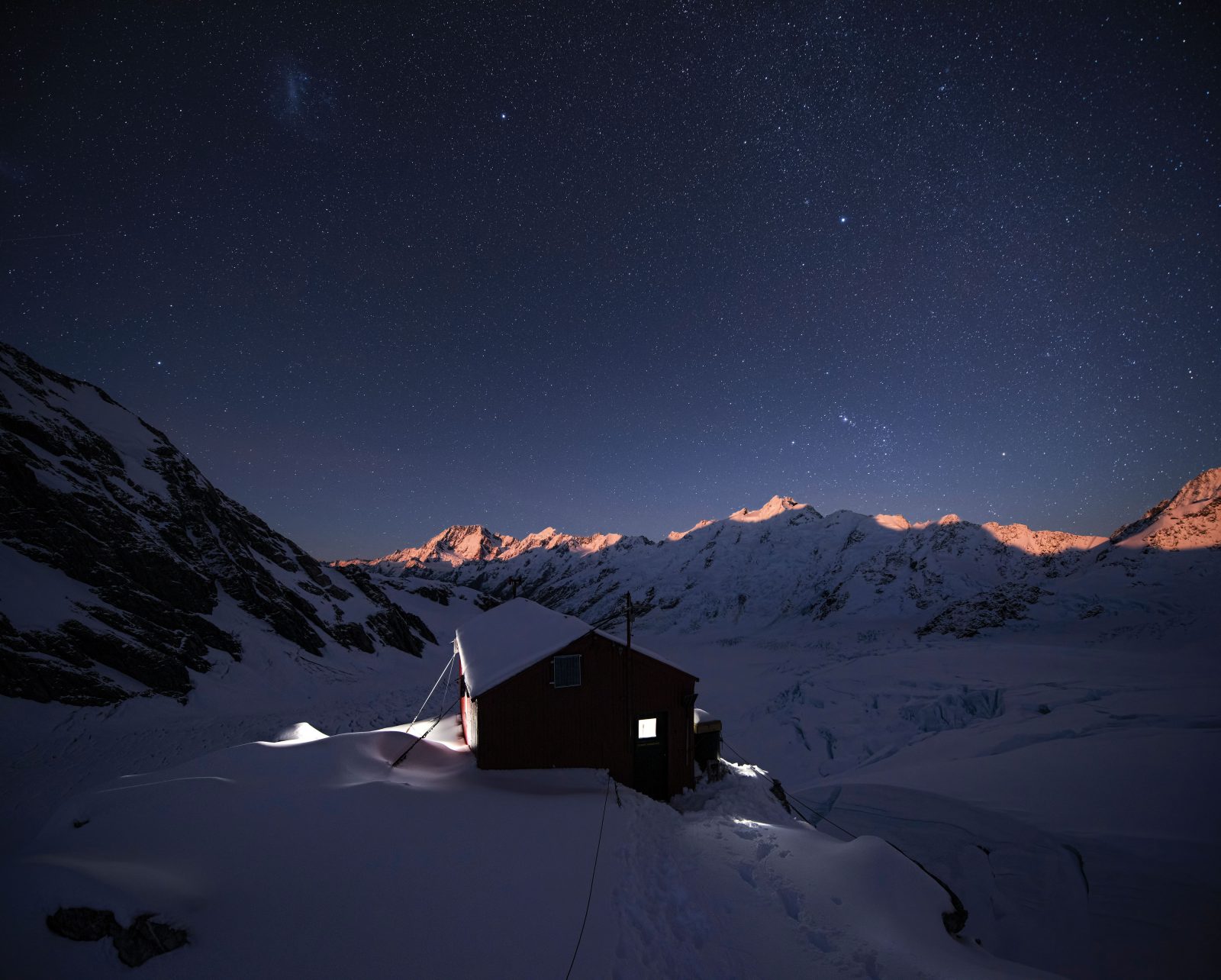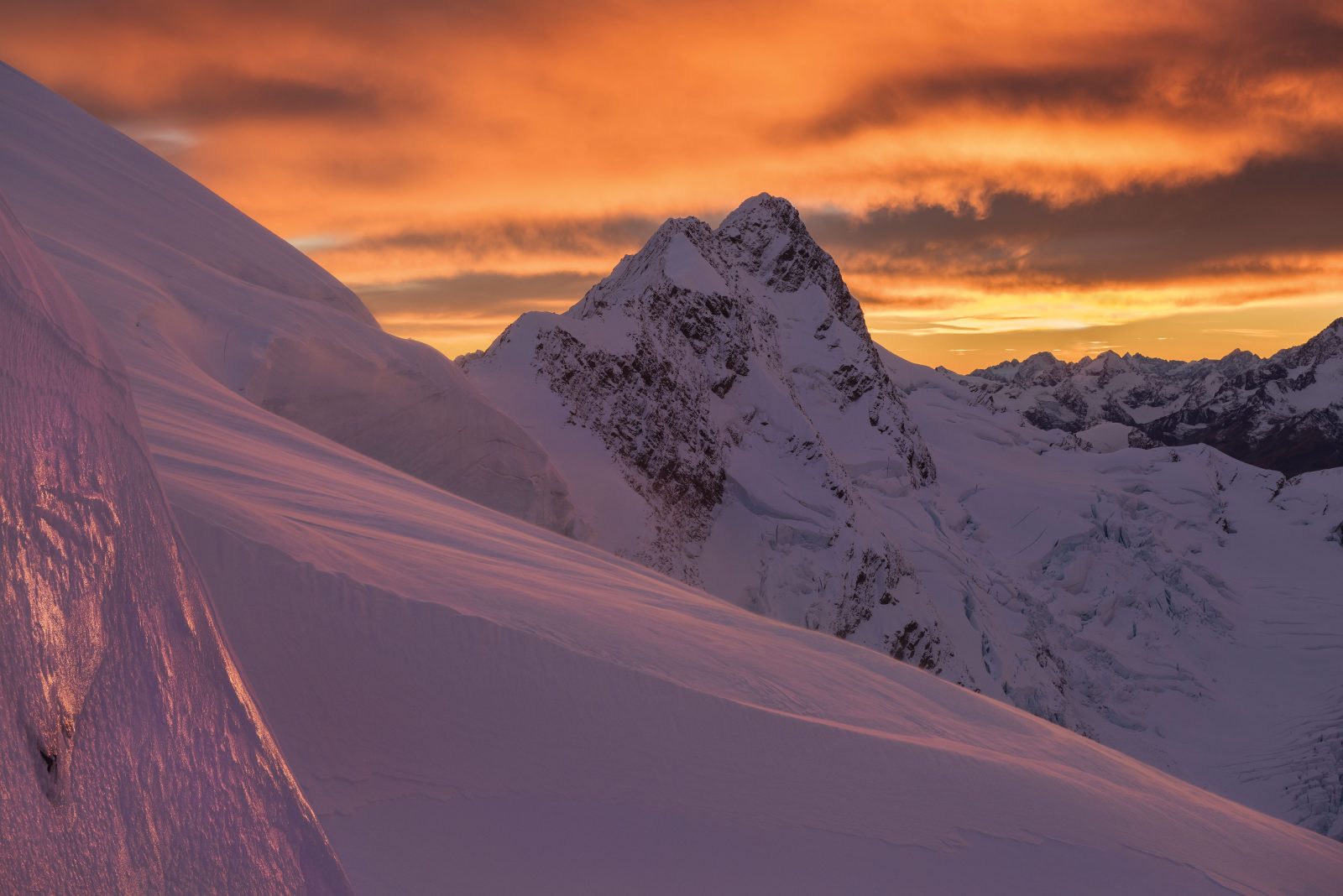
Moonlighting
Yan Zhang starts work when most photographers put their cameras away. Rather than rely on the sun, Zhang uses moonlight, starlight and the frail beams from climbers’ headlamps to illuminate his landscapes, capturing a rare and ghostly vision of our high places.

Mt Cook Village is an improbable place. Arriving feels like entering another world, one where the scale of the land has shifted. First the floodplain expands, widening, and the mountains seem to grow from it, larger and larger. Meanwhile, the palette changes: purple-grey shadows, gold tussock. Some visitors are seized by the place, and the mountains never let them go again.
This is inconvenient—Mt Cook Village is in the middle of nowhere, not close to anything, in the centre of the South Island but off to the side, the opposite side from where a heart would be.
Yan Zhang, a photographer and computer scientist, became stuck there in the winter of 2013. He was on a family holiday with his wife and two daughters, but a severe storm cut the only road out, and it was impossible even to leave the Alpine Lodge. To pass the time, Zhang picked up a book, Pat Barrett’s True South, and leafed through photographs taken in the mountains above, in places only climbers can reach. The pictures in the book captivated him. He’d been making “normal photographic landscapes”, he says, on his trip around New Zealand, but here were things far from normal. Sights he’d never seen. In a moment, he knew how he’d approach vistas like these. And in another moment, he’d resolved to do it.
“I didn’t have any experience in the mountains,” he says. “Before, I only saw these snowy mountains from pictures, from the movies—it wasn’t so real. But from that point, I thought, ‘I really want to get into the snowy mountains’.”
Zhang leads a research group in artificial intelligence—he’s a professor at Western Sydney University, where he’s worked since 1995. (He studies how machines conduct intelligent reasoning, and at the moment, his group is collaborating with IBM Australia to develop a framework for sharing information securely.) Originally from Wuhan, the largest city in central China, he arrived in Sydney in 1990 to start his PhD, and he’s been there ever since. Picking up a camera in 2007 gave him more excuses to go outdoors and capture landscapes—in the Blue Mountains west of the city, around the coastline and across the Tasman.
Zhang isn’t the first to have been enraptured by a picture of the Southern Alps. More than a century ago, another Sydneysider saw photographs of the mountains during a trip to Christchurch and immediately set off for Mt Cook Village to look at them for herself. It was a four-day journey back then, but Freda du Faur later described her 1906 visit with exuberance bordering on enchantment.
“From the moment my eyes rested on the snow-clad alps I worshipped their beauty and was filled with a passionate longing to touch those shining snows, to climb to their heights of silence and solitude, and feel myself one with the mighty forces around me.”
Du Faur soon returned to Mt Cook Village and enlisted the help of mountain guides to begin climbing. “The great peaks towering into the sky before me touched a chord that all the wonders of my own land had never set vibrating, and filled a blank of whose very existence I had been unconscious.”
Four years later, she became the first woman to scale Aoraki/Mt Cook.

Zhang likewise returned to Mt Cook Village, six months after he’d been snowbound there, for a mountaineering course. There, he met climbing partner Mark Watson, and on future trips the pair crossed Ball Pass, and climbed in the Darran Mountains in Fiordland. There’s something alien about these landscapes, says Zhang, something far from human, as though they’re still in the process of being made. “I really want to capture the raw beauty. One of these things is the night sky in the mountains.”
The stars led people to New Zealand, and over Aoraki/Mt Cook National Park, the night sky is as detailed and vivid as it was back then—there are few lights to dilute its glow. Just up the road is the internationally recognised Dark Sky Reserve of the Mackenzie Country and Tekapō.
Astronomical photographers know a few things that city-dwellers forget. That a full moon is bright enough to cast shadows, even to read by. That winter is when the galactic core of the Milky Way—thick bunches of stars clustered together—rises into the centre of the sky, like powdered sugar dusted over a cake. That the stars rotate around a blank area of sky, because there’s nothing to mark the south celestial pole.
Most photographers who shoot by night focus on starscapes, but Zhang is equally interested in the land—its forms and textures, and how they change under different qualities of light, depending on the fraction of the moon that’s visible, or whether clouds draw shut like curtains over the stars.
“Many photographers—they like to shoot sunrise, sunset, very bright, very colourful, and I’m enjoying this, but for myself I’m more into something low light, dark,” he says. “Basically, my own personality is that I like pictures to be more moody. I think these scenes are more my emotions.”
Instead, Zhang likes the edges of the day, the times when the light becomes ethereal, when it has just begun to change: the moon illuminating a distant peak, or the hint of the sun below the horizon.
Zhang comes from a family of artists. His grandfather was a well-known painter in China, depicting animals and flowers, and a master of Hunan silk-thread embroidery, which involves strong contrasts of light and shadow.
“I might inherit a bit of artistic intuition from my mother’s side,” Zhang says.
Perhaps his work mixes Eastern and Western styles, he reflects—the former being about harmony and broad appeal, the latter focused on individual experience and self-expression.


In 2017, Zhang began hiring professional guides to help him access higher areas, climbing the 3194-metre Lendenfeld Peak on the western side of Aoraki/Mt Cook National Park—again following in the footsteps of du Faur, who was the second person known to climb it—and making an attempt on Mt Aspiring in April 2018. But his luck with the weather followed him, and he was trapped in Colin Todd Hut on the flanks of the mountain for five days. The storm cleared just as he had to leave, but he put his last night to good use.
He set up his camera in front of the hut before night fell, and shot an image there every few minutes from 7pm until 5am the next day—a ten-hour stint. “I captured about 400 frames—each frame captures different things, like the stars and the Milky Way and the mountaineers going to the mountain.”
Combined into one image, it shows the lights of climbers setting off for the summit, and the peak faintly lit by the stars.
In many ways, Zhang’s approach is the opposite of a mountaineer’s.
“Normally they want to be lightweight, and they want to be quick, and push to the summit. If you want to take photos of these mountains, you have to carry a lot of weight. Normally I carry 25 to 28 kilograms to the mountains. It’s harder than normal mountaineering.
“The other side is that we don’t necessarily always go to the summit—we’re looking for some positions that have the best view.”
Zhang’s camera kit is simple—one camera body, two lenses, spare batteries. The weight comes from the heavy tripod. Long exposures mean the camera must be immobile for up to 10 hours at a time. Zhang typically hangs his backpack from the tripod, the weight stabilising it further.
And then there’s the lack of sleep to contend with. After the sun sets, it takes another 90 minutes for its light to fully fade from the sky. In summer, nights are short, and mountaineers typically start well before dawn. While his guide sleeps, Zhang takes pictures—sometimes shooting all night, sometimes rising at the same time as the moon.
Now, his photographs continue the cycle of awe and motivation. They invite the next generation of mountaineers to look at an image and think, ‘I want to stand there and see it for myself.’
“I think not many people have done this work,” he says. “I’m one of the beginners.”

Zhang, with a large wall of ice to his left, photographed the 2041-metre Mt Broderick as his fellow climbers held onto the rope keeping him safe.
















